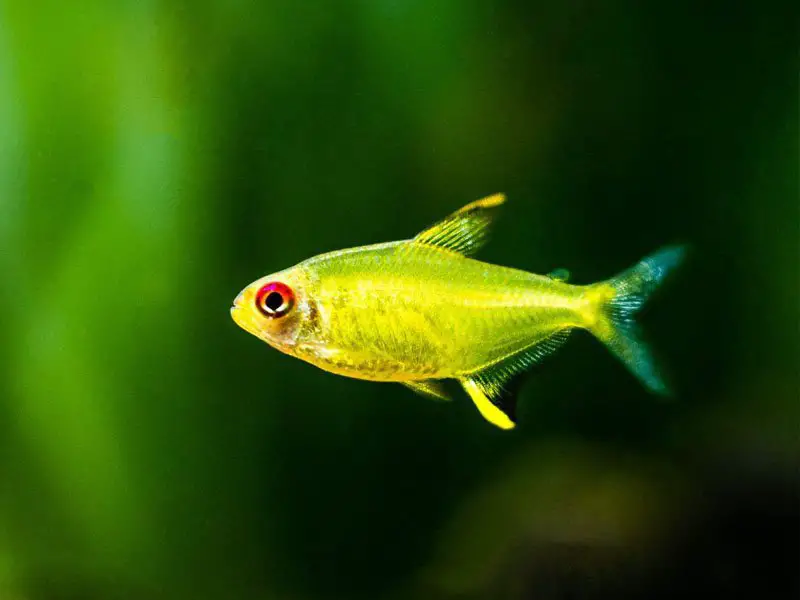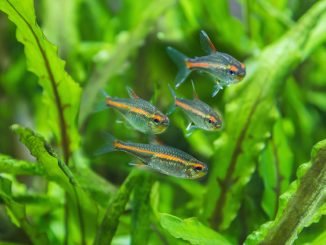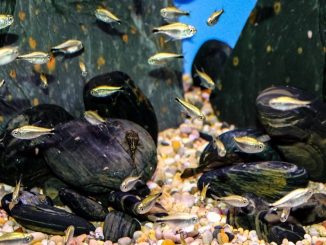
Lemon tetra fish are native to the tropical freshwaters of South America.
They belong to the Characidae family and are one of the smallest tetra fish species. Measuring up to two inches long when fully grown, lemon tetras are small and speedy additions to an aquarium.
Aquarists often introduce lemon tetras into their aquarium because these tetras are readily available at local pet shops. Lemon tetras are brightly colored tetra fish that swim in the tank peacefully and are hardy and easy to care for.
Lemon tetra fish are ideal for keeping in a beginner’s tank or for breeding purposes.
TABLE OF CONTENTS
Lemon Tetra Facts & Overview

| Category | Rating |
| Care Level: | Easy |
| Temperament: | Calm but active swimmers |
| Color: | Golden or yellow with slightly transparent bodies |
| Lifespan: | 6–8 years |
| Size: | ~2 inches |
| Diet: | Live or frozen brine shrimp, mosquito larvae, and bloodworms |
| Family: | Characidae |
| Minimum Tank Size: | 20 gallons |
| Tank Set-Up: | Tropical freshwater |
| Compatibility: | Compatible with other small community fish |
The scientific name for the lemon tetra is Hyphessobrycon pulchripinnis. Lemon tetras are part of the Characidae family of tropical or subtropical fish.
Lemon tetras live in highly vegetated habitats in the Amazon River, so keeping plenty of natural live plants and filtered lighting will benefit the tetra fish in home aquariums.
Lemon tetras cost under $6 per fish.
Appearance & Behavior

Lemon tetras measure up to five centimeters long. Adult tetras have yellow-tinted translucent bodies, with black and yellow markings on their anal and dorsal fins.
Female lemon tetras have thicker bodies than male fish. Fully grown male lemon tetra fish have a more pronounced black edge on the fish’s anal fin. The difference between male and female lemon tetras becomes more evident as the fish mature.
The lemon tetra is one of the best types of tetra fish to keep in a home aquarium. Tetras are hardy fish and can withstand changing environments, which makes caring for them incredibly simple.
Lemon tetras swim around the aquarium leisurely, so swift movements and frantic swimming are a sign of distress.
If you’re wondering why your fish die, it’s important to note that distressed fish is more likely to die earlier than their life expectancy.
Determining whether a female lemon tetra fish is pregnant or sick can be challenging. Some diseases can cause the tetras’ stomachs to swell, resembling the stomach of a pregnant fish.
Lemon tetras lay eggs, so the female fish never keeps the eggs in her belly for long. Look out for bubble nests in the tank for an indication that the tetras are ready to spawn.
Typical Behavior
Lemon tetras have a natural desire to school together. Lemon tetras are passive and calm most of the time, especially when they share a tank with other easy-going fish.
Introducing aggressive fish into a lemon tetra tank will cause lemon tetra fish to display defensive behavior.
Lemon tetras spend most of their time near the top of the tank. However, they will occupy the midsection and bottom of the tank during meal times.
Lemon tetra fish aren’t shy, but providing them with plants and small bits of driftwood will give the tetra a sense of security and a place to rest.
Tetra fish species are diurnal fish, so lemon tetras sleep during the night and are active in the day, so having an appropriate day to night light cycle in the aquarium is crucial.
Lemon Tetra Care

Lemon tetras are easy to care for. Tetras will thrive in freshwater tanks decorated with live plants and natural driftwood decorations.
Feeding lemon tetras is straightforward. Overfeeding lemon tetras will harm them, so it’s crucial to keep feeding sessions short. Lemon tetra meal times should last up to three minutes. Remove any food left in the tank after the three-minute mealtime is over.
Lemon tetras will develop diseases and infections if their aquarium isn’t kept clean. Fish keepers should put new fish into isolation to avoid contaminating the community tank.
Disease
Lemon tetras are susceptible to common aquarium-related diseases and infections. Keep an eye out for the following conditions and treat the fish accordingly:
- Anchor Worm — Anchor worms need to be removed from the affected area with tweezers. Treat the area with an antibiotic ointment once the area has been dewormed.
- Dropsy — An accumulation of water in the stomach causes dropsy. Dropsy should be treated with antibiotics and adding a saline solution to the water.
- Mouth Fungus — Mouth fungus will eat away at the fish’s jaw. Treat mouth fungus with antibiotics until all signs of the fungal infection are gone.
Habitat and Tank Requirements
Lemon tetras do not appreciate brackish water. Tetra fish are native to the narrow streams in the tropical water of the Iquitos region of the Amazon.
Mimicking the tetra’s natural habitat as closely as possible is crucial for their health and wellbeing. Filling the tank with floating plants and ferns is advised.
If the aquarium is exceptionally spacious, incorporating moss and algae will also boost the ambiance in the tetra tank.
Maintaining a slow water flow is just as crucial as the plants and decorations in the tank. Fast flowing water will confuse and distress the lemon tetras.
Tank Conditions
Keep the lemon tetra tank within the following water parameters at all times to ensure optimal health.
- Ideal water type: Lemon tetras thrive in tropical freshwater. Treating tap water with a dechlorinator is ideal for use in a lemon tetra tank. Using tap water will also keep maintenance costs down when performing regular water changes.
- Tank size: Lemon tetra fish are tiny but highly active swimmers and therefore require plenty of room in an aquarium. A 20-gallon fish tank or bigger is ideal for lemon tetras. Ensuring the tank is big enough for the fish species allows aquarists to decorate the tank with the desired plants and accessories that the tetra requires and leave plenty of swimming space.
- Ideal water temperatures: The perfect water temperature in a lemon tetra tank is 720 to 820 Fahrenheit. As you can see, the temperature range is very broad and gives fishkeepers the chance to pair the lemon tetras with more temperature-specific fish. Keeping the water temperature between 75° to 78.8° Fahrenheit will encourage tetra fish to spawn.
- Substrate: Delicate sand substrates are ideal for lemon tetra fish tanks. However, a fine gravel substrate will also work well. Adding fine sand to the bottom of the tank mimics the substrate at the bottom of the South American rivers that lemon tetras inhabit in the wild.
- Decorations and plants: Decorate the substrate with bits of driftwood and natural wood accessories to replicate the tetra’s natural habitat. Avoid adding plastic plants and accessories to the tank as the decorations can damage the fish.
- Water pH levels: Aquariums with a pH level between 5.5 to 8.0 are perfect for lemon tetra fish. The flexible pH level ranges are a reason why lemon tetras are great tank mates for fussy fish.
- Filters and bubblers: Using a standard water filtration system is more than enough for lemon tetra tanks. Fitting the aquarium with a bubbler is not a good idea in lemon tetra tanks. Lemon tetras prefer swimming in slow-flowing water, so bubblers bother the tetra greatly.
Tank Mates
Lemon tetra fish are very peaceful and easy-going fish. Tetras are shoaling fish that display schooling behavior. Keeping lemon tetra fish with neon tetras and other tetra species is ideal.
Dominant and aggressive fish like cichlids are not appropriate in lemon tetra tanks as the cichlids will bite and nip at the tetras, causing physical damage and emotional distress.
Bottom-dwelling fish are also great tank mates as the bottom dwellers will not get in the lemon tetra’s way.
Here are some great lemon tetra tank mates to consider:
- Danio — Danio fish are hardy and tolerant of varying tank conditions, much like lemon tetras.
- Rasbora — Rasbora fish are related to barbs, danios, goldfish, and koi. Rasbora fish need to be kept in shoals of 10 or more fish.
- Corydoras — Corydoras are also known as cory catfish. Cory catfish are slow, bottom-dwelling fish that will not get in the way of the lemon tetra’s speeding around the tank.
Diet and Feeding
In the wild, lemon tetra fish feed on crustaceans, plant matter, and invertebrates. Bloodworms, shrimp brine, and mosquito larvae are great alternatives for aquarium-grown lemon tetras.
High-quality protein-rich fish food flakes are also good for feeding lemon tetra in home aquariums.
Lemon tetra should eat two or three times per day, and the majority of their diet should come from fish food flakes and pellets, with the addition of live or frozen food three times per week.
Breeding

Breeding lemon tetras is easy. Lemon tetras are spawning, egg-laying fish that both beginners and expert fishkeepers can breed without hassle. Follow lemon tetra breeding steps for the best outcome:
- Move the Fish to a Breeding Tank
- Move the female and male lemon tetras into a breeding tank so that they don’t get disturbed by other fish species in the tank. Remember to decorate the tank with live plants and dim lighting.
- Decorate the Tank and Adjust the Water Parameters
- Plenty of live plants such as fern and moss will help the tetras get in the mood. Keep the water parameters consistent to avoid stressing out the fish.
- Wait for the Fish to Spawn
- Keep one male fish for every four females in the breeding tank and feed the lemon tetras a diet of brine shrimp or bloodworms to prompt spawning. If all is going well, the male tetra fish will chase the females and flap around their fins to entice the females into breeding.
- Remove Adult Fish from the Tank
- Once the spawning ritual is complete and eggs have been laid and fertilized, move the adult lemon tetras back into their community tank.
- Keep the eggs and fry in a breeding box so the adult tetras won’t eat their immature young. Breeding boxes are more cost-effective than keeping a fry tank and are a great option for aquarists on a budget.
Should You Get a Lemon Tetra for Your Aquarium?
Lemon tetras are easy to care for and even easier to breed as long as the tank size, water conditions, and decorations are suitable for the species.
Lemon tetras are great tropical freshwater fish that give aquarists the option of pairing their fish with a wide range of fish species, which makes tetras incredibly popular worldwide.








Be the first to comment